Medical imaging has always been a cornerstone of healthcare, providing the foundation for accurate diagnosis and effective treatment planning. Among the many imaging techniques, Magnetic Resonance Imaging (MRI) stands out for its ability to capture high-resolution details of the human body without exposing patients to harmful radiation. Yet, MRI in its traditional form is no longer enough. In the digital era, a new frontier is emerging—the convergence of MRI and visual technologies such as 3D imaging, artificial intelligence (AI), augmented reality (AR), and virtual reality (VR).
This convergence is redefining how healthcare professionals interpret, share, and apply medical imaging, turning scans into dynamic tools that empower clinicians and patients alike.
The Evolution of MRI: From Static Images to Interactive Visuals
MRI was revolutionary when first introduced, enabling physicians to peer inside the human body with unmatched clarity. Over time, MRI machines became faster, more precise, and capable of capturing even subtle tissue differences.
But today’s advancements go far beyond sharper images. The integration of visual technology is transforming MRI scans from static slices into interactive, lifelike experiences. For instance:
- 3D MRI reconstructions provide surgeons with multi-angle views of organs and tissues, aiding in preoperative planning.
- 4D imaging adds the element of motion, allowing clinicians to observe processes like blood flow or joint movement in real time.
- AI-powered visualization highlights anomalies automatically, reducing diagnostic errors.
What once was a flat grayscale image is now a dynamic medical map that can be explored, manipulated, and shared across platforms.
How Visual Technology Enhances MRI in Healthcare
1. Artificial Intelligence and Machine Learning
AI-driven visualization is perhaps the most impactful innovation in MRI. Algorithms trained on massive datasets can:
- Detect subtle patterns invisible to the human eye.
- Differentiate between benign and malignant tissue.
- Automate routine measurements, freeing radiologists to focus on complex cases.
This makes MRI interpretation faster, more reliable, and more personalized.
2. 3D and 4D Imaging for Surgical Precision
Traditional MRI slices can be challenging to interpret, especially for surgical planning. With 3D and 4D models, clinicians can rotate, zoom, and even simulate procedures before entering the operating room. This reduces risks and improves outcomes.
3. Virtual and Augmented Reality Applications
- Virtual Reality (VR): Medical students and trainees can immerse themselves in realistic 3D MRI scans, exploring anatomy interactively.
- Augmented Reality (AR): Surgeons can overlay MRI data onto a patient during procedures, enhancing accuracy in real time.
4. Cloud and Collaborative Platforms
Cloud-based MRI platforms enable global collaboration. A radiologist in one country can share annotated scans with a surgeon across the globe, all in real time. This democratizes expertise and speeds up second opinions.
Patient-Centered MRI: Redesigning the Experience
For patients, undergoing an MRI scan can be daunting. Long scan times, loud noises, and claustrophobic machines often heighten anxiety. By applying visual technologies with design thinking, the patient experience is improving:
- Ambient MRI environments let patients choose calming sounds or visuals during scans.
- Shorter scan protocols reduce time inside the machine.
- Interactive explanations using 3D scans help patients understand their diagnoses better, fostering trust and compliance.
This patient-first approach ensures that technology serves not just medical professionals but also those receiving care.
The Impact on Education and Training
Medical education is being transformed by MRI combined with visual technologies. Instead of static images in textbooks, students now learn using interactive, lifelike scans.
- VR-based simulations allow trainees to practice reading MRI scans and diagnosing conditions in safe, controlled environments.
- 3D anatomical models derived from MRI data help in teaching complex systems like the brain, heart, and musculoskeletal structures.
This shift not only improves understanding but also accelerates learning for future healthcare providers.
Challenges in the Convergence of MRI and Visual Tech
Despite the promising innovations, challenges remain:
- Cost of implementation: Advanced imaging systems, AI software, and AR/VR platforms are expensive and may be inaccessible to smaller hospitals.
- Data security: Cloud-based imaging raises concerns about patient privacy and cybersecurity.
- Training gaps: Clinicians must learn how to effectively use these new technologies, requiring ongoing education.
Overcoming these challenges will require partnerships between healthcare institutions, technology companies, and policymakers to make the innovations more affordable and widely available.
The Future of MRI and Visual Technology
Looking ahead, the convergence of MRI and visual tech will only deepen. Some exciting possibilities include:
- Personalized imaging pathways tailored to each patient’s unique anatomy and medical history.
- Real-time diagnostic feedback, where AI highlights problem areas as the scan is being taken.
- Immersive telemedicine, where patients and doctors can explore MRI scans together in VR, even remotely.
- Integration with wearable tech, enabling continuous health monitoring combined with advanced imaging for early disease detection.
This future envisions MRI not as a single diagnostic snapshot, but as a living, evolving tool that adapts to each patient’s journey.
Conclusion: A New Era of Medical Imaging
The convergence of MRI and visual technology marks a turning point in healthcare. By blending the precision of MRI with the power of AI, 3D modeling, VR, and AR, medical imaging is evolving from static pictures into interactive diagnostic ecosystems.
For clinicians, this means better accuracy and efficiency. For patients, it means clearer understanding, reduced anxiety, and more personalized care. For educators, it represents a revolution in how medicine is taught.
Ultimately, this convergence is redefining medical imaging—turning MRI into more than just a diagnostic tool, but a bridge between technology, medicine, and human-centered care.
Also Read :
